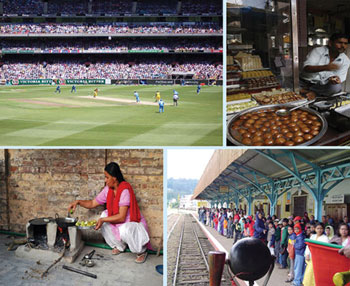3 Using pictures to make students think about related variables
Equations relate variables and constants. Apart from identifying which is which, another interesting question in mathematics is to what extent variables in a given context relate to each other. A good way to help students understand this is by asking them to look at pictures and come up with their own ideas of related variables.
In the next activity, students are presented with four situations. They need to identify all the variables they can think of and then determine the pairs that may be related.
Activity 3: Finding related variables
Preparation
For this exercise, divide the class into small groups (pairs, threes, or fours) and ask them to work collaboratively. Decide how you will organise the groups. It is important to do this before the lesson to save time during the lesson. Use the images from Figure 1 below or use your own similar images, for example from newspapers.
The activity
Tell your students to look at the four images in Figure 1. In each case, make a list of variables that may depict any aspect relating to the image.

For each list, prepare pairs of variables that you think may be related. Create a specific context involving these variables and represent that context as an equation. Use your imagination!
At the end of the activity, ask groups to share their thoughts and then evaluate them.
Case Study 3: Mr Bhatia reflects on using Activity 3
I decided that the work would be done in groups of fours. We made 11 groups, and pictures were assigned to each group with the instruction to work out the different variables and produce equations.
They all came up very enthusiastically with the different variables in the pictures. Without further prompting they could also, to some extent, identify the ones that they thought were related and those they thought were not. Then some groups seemed to get stuck. They could not think of how to form connections.
I had been circulating around the class but I paused the activity at this point and asked for some examples. I said even a tiny idea would help all others to get unstuck.
Shobha and her group were working on the picture of the lady frying something and said that if there were ‘y’ people in the house and each ate ‘x’ puris, then if the lady made 40 puris, xy = 40. Mona from the second group was working on the same picture and came up with a context related to the material used. They decided that the lady was making pakoras. So if she used ‘x’ kg of besan (gram flour) and ‘y’ kg of potatoes, and if ‘a’ was the cost per kg of besan and ‘b’ was the cost per kg of potatoes, her expense would be ax + by.
I praised these two volunteers and saw that their examples were enough to move the other groups on in their discussions. After a while I asked each group to make a presentation of one of their ideas and we had some good presentations. I was actually very impressed with how easily and naturally the students introduced several variables within an equation – something I would have been reluctant to expose them to from the textbook.
Pause for thought
|
2 Contextualising equations
